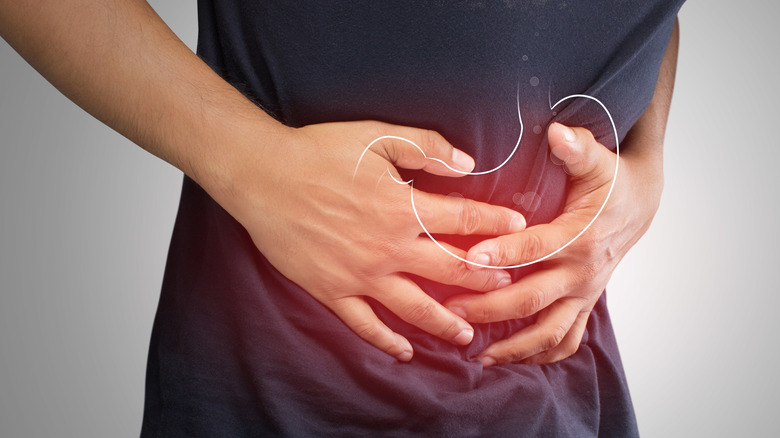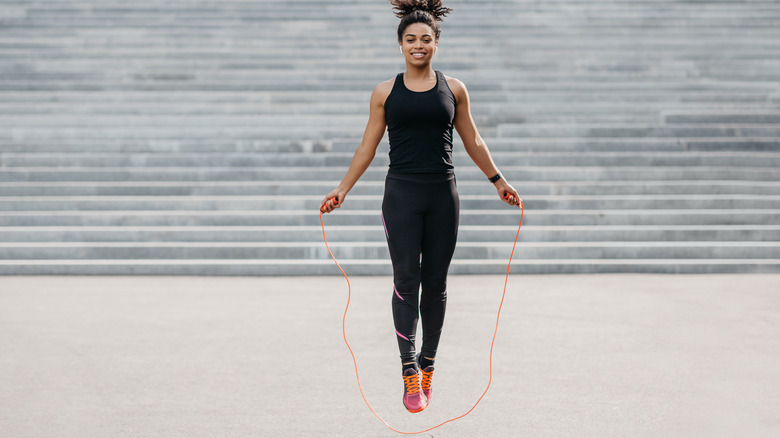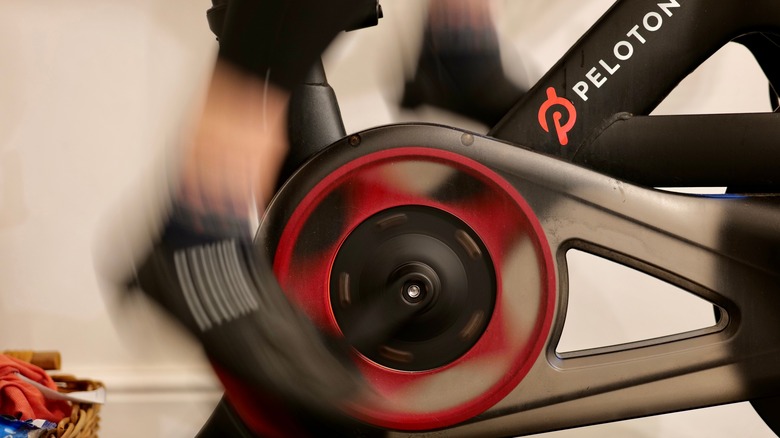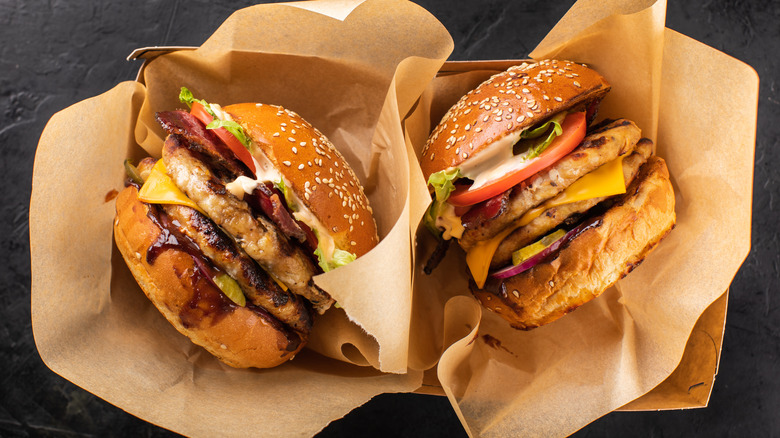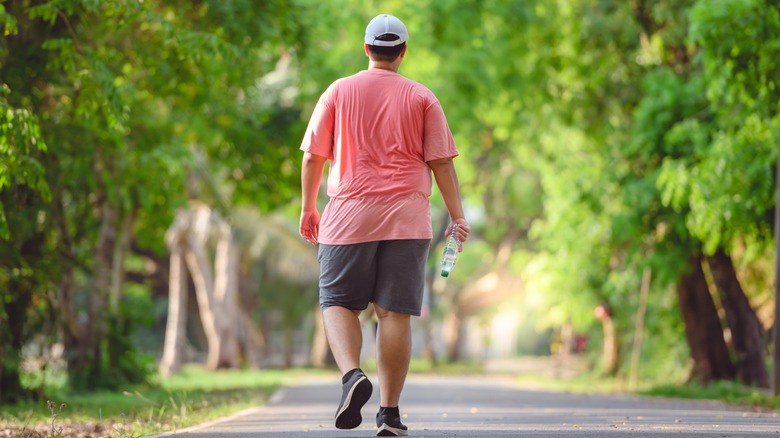Tips For Exercising When You Have Acid Reflux
You've probably felt it before — that uncomfortable burning, acid feeling in your stomach and chest after a delicious meal. The words acid reflux, heartburn, and GERD are often used synonymously, but they are technically different things. Acid reflux is when some of the acid in your stomach comes up into your esophagus, while heartburn is the feeling that it creates (via Medical News Today). GERD stands for gastroesophageal reflux disease, which is usually diagnosed if you experience acid reflux and heartburn frequently. GERD is actually the most common digestive issue in the U.S. — 20% of Americans have received the diagnosis.
So what causes it? Your stomach uses hydrochloric acid to help break down foods, and while the stomach lining is built to tolerate this acid, your esophagus is not. Sometimes the valve that closes off the esophagus from the stomach fails, resulting in acid reflux. There are many different potential causes, including risk factors like being overweight, smoking, certain medications, pregnancy, and lack of exercise. Diet plays a huge role as well, with some known triggers being caffeine, alcohol, fatty or spicy foods, eating too much, carbonated beverages, and more.
How exercise can help (and hurt)
According to a recent scientific study published in Neurogastroenterology & Motility, weight loss has been shown to reduce GERD symptoms, especially in people that are overweight. But the catch-22 here is that while maintaining a healthy weight and exercising can help prevent or reduce symptoms of heartburn, some types of exercise can actually aggravate acid reflux symptoms. "There are certain activities that can trigger reflux, and exercise is one of them," says Dr. Sumona Saha, a gastroenterologist and assistant professor of medicine at the University of Wisconsin School of Medicine and Public Health in Madison (via Everyday Health). The trick is finding which exercises are generally safe for you to try, and which ones may trigger an acid reflux attack. Anything that puts pressure on your abdominal wall, stomach, or esophagus area could set off symptoms. There are also certain precautions and preparations you can take to reduce your chances of experiencing heartburn while working out.
Avoid high-impact exercise
According to an article in Sports Medicine, when the length or intensity of a workout goes up, so do the chances of getting heartburn. High-impact exercise, which involves movement that puts a large amount of impact on your joints and body, can trigger acid reflux (via Healthline). This type of exercise generally requires sudden movement that bring both of your feet off the ground simultaneously, putting more force on your body when you return to the ground (via Dynamic Physio). Some types of high-impact work outs that can cause heartburn include running, sprinting, weightlifting, gymnastics, cycling, jumping rope, and stair-climbing. These types of exercise can put extra pressure on the abdomen and trigger symptoms (via Everyday Health).
However, that doesn't mean that you have to swear off these exercises forever. Some people don't experience acid reflux with high-impact movement. Healthline recommends trying low-impact exercise first and observing how you feel — if that doesn't trigger symptoms, slowly try high-impact workouts and see how it goes.
Low-impact exercise is the way to go
Low-impact exercises are the exact opposite of high-impact ones — they involve movement that has a low impact on your body and joints (via Dynamic Physio). These types of exercises tend to be more gentle on the body and can be modified depending on your level of fitness. These are your best bet for getting a workout in without triggering acid reflux symptoms (via Healthline). Some types of low-impact exercises that could be good for heartburn include walking, gentle jogging, yoga, stationary biking, the elliptical, or roller skating.
Swimming is another low-impact exercise that might be beneficial, but with a few caveats (via Livestrong). The problem with swimming is that the body is usually not upright during this activity, which means stomach acid may be more apt to move into the esophagus. Holding your breath or straining during swimming can increase your chances of developing symptoms, so make sure you learn how to breath properly when in the water. Also, you know that cliché that you should always wait two hours after eating before swimming? You'll definitely want to follow that tip, since swimming right after a big meal increases your risk of acid reflux.
Don't work out too soon after eating
Eating soon before exercise is generally a bad idea when it comes to acid reflux — it's best to eat two to three hours before a workout (via Healthline). Waiting at least two hours after eating before exercise allows your body enough time to digest your food, lessening the chances of workout-induced heartburn. "The less material that's in the stomach, the better. An empty stomach can't reflux, essentially," says Dr. David Levinthal, director of the neurogastroenterology at the University of Pittsburgh Medical Center (via Everyday Health). If you end up hungry before a workout, choose complex carbohydrates, since these are easier and faster for your body to digest, and can give your body an extra energy boost (via Physicians Committee for Responsible Medicine). Complex carbohydrates can be found in unprocessed plant-based foods like beans, oatmeal, quinoa, potatoes, sweet potatoes, and more. You may want to avoid eating foods that commonly trigger acid reflux, including tomatoes and tomato-based foods, citrus, chocolate, coffee, fried or fatty foods, alcohol, mint, and soda (per Healthline).
Modifying your yoga practice to avoid acid reflux
Yoga is a great low-impact exercise that can not only make you sweat, but also help you feel stronger and less stressed, reduce aching joints and back pain, and support your sleep, energy, and mood (via Johns Hopkins Medicine). In addition, according to a case report published in the International Journal of Yoga, practicing yoga in addition to taking medication can significantly relieve digestive symptoms.
However, one thing to keep in mind is that many yoga poses involve forward folds and inversions, which can put more stress on your abdominal wall and cause acid to be pushed upward toward the esophagus (via Livestrong). It's best to take a gentle and cautious approach to these movements, and don't overdo it. "A simple forward fold is fine, especially if it feels restorative, but if you're doing crunches or creating contraction in the abdomen, it may cause a flare," says Dr. Atif Iqbal, medical director of the Digestive Care Center, to Livestrong. Instead, modify poses like downward dog with blocks, or if you are practicing at home, you can even use a chair or bench to place your hands on — just focus on keeping your head and chest lifted most of the time (via Mitsou Magazine).
You may also want to consider skipping the traditional savasana in yoga — you know, that pose where you get to just lie down on the ground at the end? Instead, try grabbing props to lift your upper body so that it's slightly elevated (via Masterclass).
Avoid exercising lying down
Lying down is one of the biggest triggers for acid reflux — it's generally recommended to avoid lying down after eating and to elevate your upper body when sleeping to reduce or relieve heartburn symptoms (via Healthline). This means workouts that involve lying down, like abdominal crunches, are also off the table (phew). Most crunches not only require lying down, but also put additional constant pressure on the abdominal area. However, this doesn't mean you have to give up on your ab dreams entirely. Everyday Health recommends trying crunches on an incline bench. "My general advice for clients who suffer with GERD is to listen to their bodies and start slowly," says online fitness trainer and nutrition coach Ivana Chapman.
You can also shift your focus on exercises that work different parts of your abs, like your transverse abs, which are located deeper in your abdominal wall. Or you can try hypopressive ab exercises, which involve sitting or standing to tone your ab muscles (via Mitsou Magazine).
Walking is gentle on your stomach
If you've ever longed for a walk after a big lunch or Thanksgiving dinner, that's probably because your body intrinsically knew what you needed most in that moment — walking can not only support digestion, but it also can help relieve feelings of bloating and indigestion (via Rennie). Plus, walking is one of the best low-impact, cardiovascular exercises that is not likely to trigger acid reflux symptoms, according to certified strength and conditioning specialist Rocky Snyder, author of the strength training guide "Return to Center," speaking to Livestrong. In fact, walking can actually lower the intensity and frequency of heartburn. And the more you walk, the greater your chances are of losing weight, since walking often causes your body to spend energy and calories (via Livestrong).
All that said, it's still possible that walking could prompt an acid reflux flare. If this happens to you, ensure there is adequate time between your walk and when you ate your last meal. You can also drink some extra water, which can help keep everything moving through your digestive system at a fair clip.
Lifting heavy weights may aggravate acid reflux
Strength training with a lot of weight can trigger acid reflux, as gastroenterologist Dr. Anjali Mone told Livestrong. To avoid heartburn, the best practice is to focus on high reps with low weight so as to put less pressure on the body, including the stomach.
Also, you'll want to lift weights while standing or sitting, and avoid lying down on a bench. Indeed, being as upright as possible can help — if you're hunched over or putting too much constant pressure on your abdomen, it could trigger a flare. Luckily, many weight exercises can be adapted. For instance, when working your triceps, rather than sitting down and leaning your body forward to extend your arm back behind you, try standing up and lifting the dumbbells up and down behind your head (via Mitsou Magazine). "Adjusting the incline of the body so the head is more elevated than the stomach helps to decrease the pressure. Any exercise can be modified to any upright position so that your head is more elevated than your stomach. This helps in that it doesn't stir up the stomach acid, which can usually leak back into the esophagus, causing further irritation," shares trainer Sonia Renaud via Mitsou Magazine.
Don't wear tight, constrictive clothing
Yoga pants have long left the yoga studio — their comfort and simplicity makes them perfect for just about anything, from a casual night out to a work zoom meeting. As more people are spending time at home due to the pandemic, activewear and "athleisure" clothing is trending (via Forbes). But athleisure may not be the best clothing choice for someone struggling with acid reflux. You may want to opt for sweats over tight-fitting leggings, especially the next time you exercise. Unfortunately, snug clothing tends to put more pressure on the abdomen and stomach, increasing your chances of developing heartburn symptoms (via Everyday Health). Common activewear that seems to cause problems for those struggling with GERD include pants with elastic waistbands, skin-tight tops, too-tight sports bras, clothing with spandex or Lycra, waist trainers, and restrictive shapewear (per Maryland Surgery Center). Instead, choose loose-fitting clothing, like jogger pants with an adjustable waistband and flowy shirts (per Bustle).
Avoid activities that cause you to gasp for air
One of the reasons high-impact exercising is discouraged for those with acid reflux is because it increases your chances of becoming out of breath and gasping for air, which in turn might relax your lower esophageal sphincter, resulting in heartburn (via Healthline). "Gulping" the air can put too much pressure on the esophagus, causing the valve to malfunction and triggering acid reflux (via GI Society). Plus, swallowing air is believed to cause acid reflux, which can happen when you take shallow, rapid breaths during a workout (via Everyday Health). According to a study published in Townsend Letter, focusing on your breathing patterns can help reduce your likelihood of experiencing acid reflux symptoms. Also, avoid using a water bottle with a straw, as drinking through a straw causes you to swallow air with every sip (via Everyday Health). Skip using chewing gum, too, which has the same effect.
Breathing exercises can stave off a flare-up
According to a recent small study, a certain type of deep breathing exercise called diaphragmatic breathing was effective in reducing symptoms of GERD in patients (via The American Journal of Gastroenterology). Breathing techniques can help you focus on your breath, resulting in more intentional breathing and reducing your chances of "gulping" air, which may trigger symptoms (via Everyday Health). In addition, breathing exercises are thought to help strengthen your lower esophageal sphincter. Some basic tips to help you get started involve simply breathing more slowly and deeply. Throughout your day, bring attention to your breath and see if you can take a few, slow deep breaths. Your breath tends to become more shallow when you're feeling stressed, so checking in with your breath during particularly stressful moments can be beneficial. Yoga and meditation can also help you develop breathing exercises.
If you'd like to try out diaphragmatic breathing, a recommended exercise is to sit up with straight posture and make yourself comfortable, breathing normally. Rest one hand on your heart and one on your low belly. To take a deep breath into your diaphragm, inhale so that your hand on your low belly moves out, but your hand on your heart stays where it is. Imagine oxygen moving all the way into your low belly, then back out again, as you inhale and exhale deeply.
Acid reflux prevention tips
Oftentimes, people find relief from heartburn with lifestyle changes and medications (via the Mayo Clinic). Typically doctors prescribe people with GERD proton pump inhibitors (PPIs) or H2 blockers, although clinical guidelines from The American Journal of Gastroenterology suggests taking these medications for only a short time period to reduce the chances of developing negative potential side effects. For those that only experience heartburn on occasion, over-the-counter medications like antacids should do the trick. One scientific study showed that diet changes can be just as effective as medications like PPIs. In this study, those that followed a plant-based diet or the Mediterranean-style diet saw similar results as those who took medication. Other beneficial lifestyle changes to help soothe or prevent heartburn include working on improving your posture, keeping a healthy weight, not smoking, consuming fiber in your diet, not eating right before bed, and elevating your upper body when sleeping (via Medical News Today).

